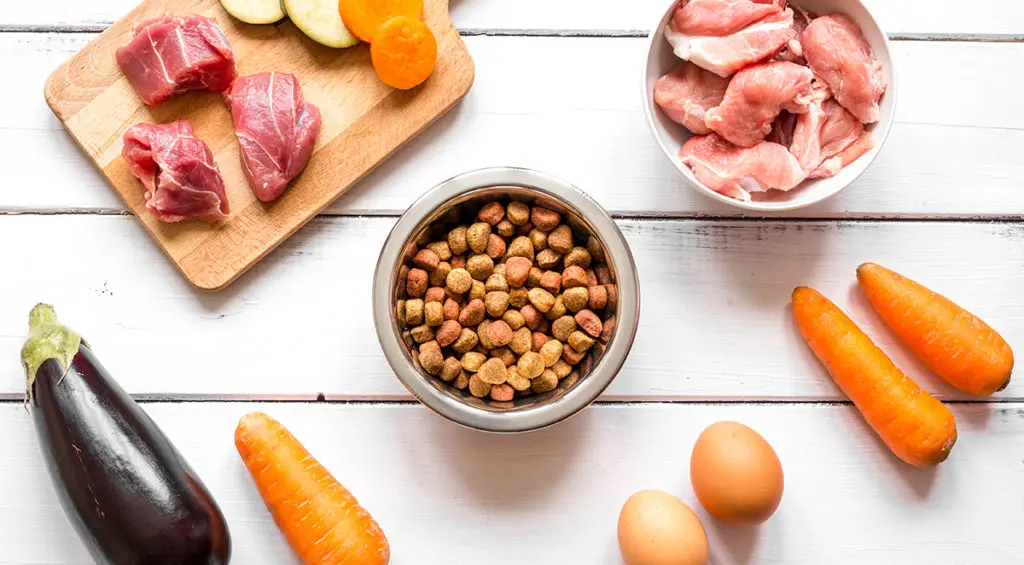Interpreting dog food packaging
It can be difficult to decide which dog food to choose. A dog’s diet can affect both their behaviour and their health, so it is important to get it right. Moreover, we all want to do the best for our dogs and the huge range of products available can be confusing. Please note that the following information is mostly covering a kibble and/or wet food diet (See also Dog feeding and diet).

Bear in mind that changing a dog’s food from one that has been fed for some time to a new product can easily upset the dog’s stomach for a day or two and, while that’s not a reason to stay on a certain food indefinitely, it is something to consider when thinking about making a change. Unless the dog is used to different types of food (rotation feeding), any change in diet should be phased in gradually over a week. Any gastric upset is usually transient and, in most cases, will sort itself out quite quickly but some dogs are more sensitive to certain ingredients and, in such a case, your vet will advise you about sensitivities and how best to feed your dog to avoid any food-related problems.
This page is designed to guide you through interpreting dog food packaging to help you make an informed decision about which food to choose.
Understanding dog food packaging
By law, food manufacturers are required to list ingredients by weight in descending order before cooking. So, fresh meat and other water-rich ingredients will appear at or near the top of the list, leading to the belief that these make up the principal ingredients. However, this isn’t really the case – for example, fresh meat contains 75% water so food containing 25% lamb before cooking will actually only contain 6-7% lamb protein in the dry food. So, as a rule of thumb, where you read 20% fresh meat, your dog will receive around 5% protein from that ingredient.
Food manufacturers may use terms to describe food content and below is shown a rough guide to how these terms equate as a percentage:
| ‘contains…’ | = less than 4% of the ingredient mentioned |
| ‘with…’ | = 4-14% of the ingredient mentioned |
| ‘rich in …’ | = 14-26% of the ingredient mentioned |
| ‘…paste’ | = 26-100% of the ingredient mentioned |
| ‘full…’ | = 100% of the ingredient mentioned |
So, in practice, if the label says ‘with chicken’ it means that the food contains between 4-14% chicken.
Artificial additives
There is no nutritional benefit from the addition of artificial additives to dog food, but they may be used for:
Artificial colouring
Colourants are used to make the food look more attractive to people and not the dog. There has long been a debate about dogs being colour blind and, while we now know that they are not, we also know that they have a more limited colour spectrum than humans with the canine colour field consisting mostly of yellows, blues, and violets. We also know that dogs don’t care what colour their food is, but the additives in the artificial colouring can affect their behaviour, just as it does with children, so if you feed your dog kibble, a bland coloured one is advisable.
Artificial flavourings
These are used to improve the palatability of dog foods but, unless the product has been manufactured specifically to exclude or include certain key ingredients for medical reasons, any high-quality pet food should not need enhancement of its palatability. Moreover, both artificial colouring and flavourings can cause hyperactivity in dogs.
Artificial preservatives and antioxidants
Dog foods need antioxidants to give them shelf life because, as soon as the fats they contain come into contact with air, they begin to oxidise and will become rancid. To avoid this, manufacturers have the choice of using natural or synthetic antioxidants;
Synthetic antioxidants are often listed as ‘EC permitted antioxidants’
E320 – BHA – Butylatedhydroyanilose
E321 – BHT – Butrylatedhydroyutoluen
E324 – Ethoxyquin
These are all comparatively inexpensive and highly effective methods of preserving dog foods, but they can also be associated with health concerns, including cancer, when fed in quantity.
The healthiest option is to preserve food naturally with tocopherols which are a blend of vitamins E and C and are commonly made from vegetable oil. These can also be used in conjunction with rosemary which is a natural antioxidant.
Meat and animal derivatives
This is a generic term for animal protein which can be sourced from any animal and from any part of the animal. Manufacturers can use different sources depending on market prices. Generally, they are sourced from the least attractive parts such as heads, feet and guts but, we should remember that, in the wild, a dog when hunting would naturally eat all these parts of any prey that they catch.
Ash
This seems a strange term, but it simply describes the minerals that would be left behind when the food is completely incinerated – such as calcium, phosphorus, iron, zinc etc. Ash is not used as a filler but is included to ensure mineral content and to dilute the recipe. The typical ash content of most commercial dog foods is around 5-8%.
Cereals
Cereals are a source of carbohydrate and provide necessary dietary fibre. However, cereals vary in their nutritional value and in their digestibility. The least digestible cereals tend to be the cheapest ones and any food source that has limited digestibility has limited value to the body.
When the term ‘cereals’ is used as a dog food ingredient, the actual grain used can vary from batch to batch and this allows manufacturers to take advantage of market prices, using whichever grain is available most cheaply at the time. So, if shown as a generic term, it has been chosen for price rather than for any specific benefit for your dog. Other manufacturers may specify that a specific cereal, such as rice, has been used for such as ‘Lamb and rice’.
Cereals can be used as bulking agents but a diet high in cereals will be cheaper to make and will have less nutritional value.
Some manufacturers try not to use cereals but use fruit, vegetables or more digestible grains such as rice instead. As in human nutrition, brown rice is preferable to white rice and this is a good alternative to cereal as a nutritional component.
Manufacturers should state on the packaging which cereals are contained in the product and some foods will be advertised as being grain-free.
Overall tips on choosing dog food
Characteristics of a satisfactory dog food
Manufacturers use a variety of terms to describe their products, but the following are standardised industry terms:
- Complete – provides adequate amounts of all the required nutrients
- Balanced – the nutrients are present in the correct proportions
- Digestible – your dog will be able to digest the food and absorb the nutrients
- Palatable – appealing enough to be eaten
- Safe – free from toxins or anything which could harm a pet
When we choose a food for our pet, we are looking over three separate time phases and need to ensure that we tick all three boxes:
- Short term – we are looking for palatability and digestive tolerance
- Medium term – control of the dog’s weight and the quality of their coat
- Long term – the development of the animal’s health over several months or years
Choose:
- A complete diet rather than a complementary one unless you are prepared to supplement the food with other essential nutrients
- Products with at least 2 named meat sources in the first 5 listed ingredients
- Pet foods preserved with natural antioxidants such as tocopherols, ascorbic acid (Vitamin C) and rosemary
- A product that names the cereal used, such as rice (which is highly digestible), or fruit/vegetables in what may be described as a ‘grain-free’ diet
- A product containing named meat sources so that each manufactured batch will be the same. This is particularly important if your dog has a sensitive stomach or allergies.
Avoid:
- Foods where the protein is listed as ‘meat and animal derivatives’
- Foods where the term ‘cereal, wheat, sorghum or corn/corn products’ appears in the first 5 ingredients)
- Artificial colourings and brightly coloured or multi-coloured foods
- Artificial flavourings
- Artificial preservatives
- EC permitted additives
- An unspecified fat source or high fat content
Remember:
- Quality of ingredients
- A kibble size that is suitable for your dog’s size
- Feed the correct amount to maintain optimum weight
- Appropriate for the life stage of your dog
- The higher the digestibility, the fewer additives and bulking agents in the food, the less faecal waste your dog will produce – a good guide to value for money
- Wean dogs onto a new diet slowly
While price can be a good guide to the quality of the nutritional elements which a product contains, it does not always follow that the most expensive product will be the best for your dog. Some less expensive products can provide excellent nutrition, but the guide shown above will help you to choose the best product within the constraints of your family’s budget. Remember that responsible dog food manufacturers work hard to ensure that the nutritional value of the products they bring to market will meet the needs of your dog and the Pet Food Manufacturers Association (PFMA) can provide more information on this topic.
And finally, remember that dogs don’t just eat for the nutritional value, they have a behavioural need to lick, tear and chew and this must be met by providing suitable chewing items. Ideally, aim for 30 minutes chewing every day, but be aware of extra calorie intake.
Help support our life-changing work...
Imagine if everyday tasks were so challenging or physically demanding they affected your quality of life. For many people living with a disability of families with a child with autism, that is their reality. Now imagine if a specially trained four-legged friend could restore your, or your family’s, independence.
The demand for our services is high and we can’t help as many people as we would like to without more funding. Please help us continue making life-changing differences for people with disabilities through the power of expertly trained dogs.
Every contribution, whatever size, is important and helps us make a difference.

